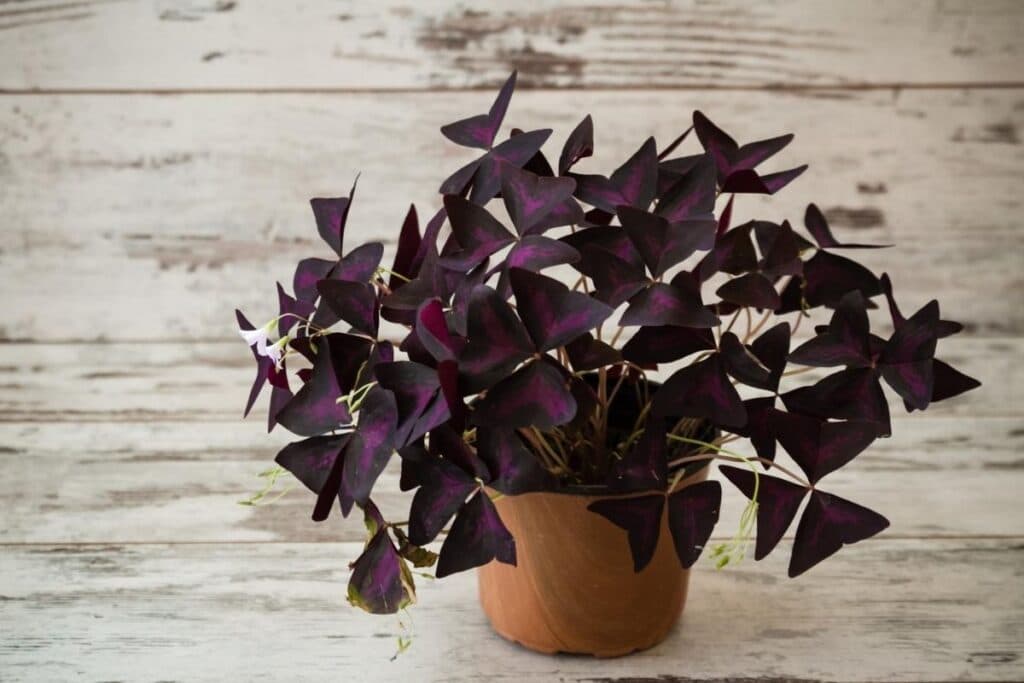Some would say that the best part of a plant is the flowers because they are often different in shape and color, particularly since they are what helps the plant attract pollinators and humans included. So it may seem ironic that most indoor plants rarely bloom and if they do, it’s because they were given special attention to do so.
To make up for the lack of catchy flowers, many common house plants bear attractive foliage instead, and one of these distinct plants is the Oxalis and the most common plant is the oxalis triangularis.
What is a False Shamrock?
Oxalis, commonly known as False Shamrock actually refers to the genus of over 850 plants of the wood sorrel family. Their three-lobed leaves resemble that of clovers hence the common name (1). The plant’s name, Oxalis, comes from the chemical oxalic acid that is found in its roots and leaves.
False shamrocks hail from the sunny tropics, native to several countries in southern South America, specifically Brazil.
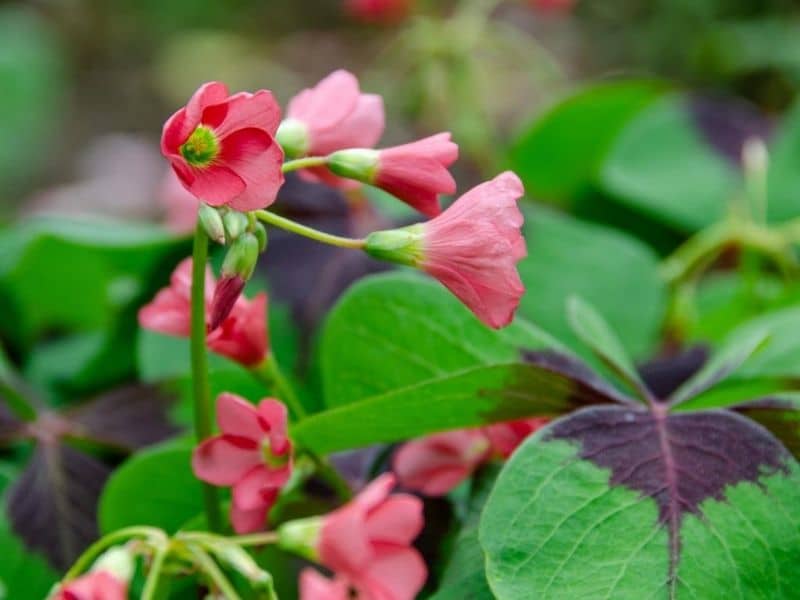
False shamrocks have a low, mounding form and are often used as groundcovers or allowed to overflow in hanging baskets, despite the delicate appearance.
The tuberous plant grows slender whitish green stems that hold the signature triangular leaves ranging from green to purple in color (2). Atop these leaves appear flimsy white, yellow or soft pink simple flowers (3).
One unique and mesmerizing characteristic of oxalis is at night, the leaves are folded up like closed umbrellas, and as the sun shines in the morning, the foliage begins to open up to receive sunlight (4).
How to Care for Oxalis Plants

Light and Water
False shamrock plants should be placed in full sun to partial shade, meaning roughly four hours of direct sunlight on most days. If you live in a hot area and decide to bring this entire plant outside, give it some protection from the hot afternoon direct sunlight.
Indoors, the false shamrock plant should be grown by a window that receives bright light. Regularly rotate the pot, so all sides of the plant end up facing the light and growing evenly. Too little light can cause the plant to become weak and leggy.
Oxalis needs constant moisture but should not be overwatered. Light and frequent watering keeps the plant well-hydrated and maybe more during the growing season (4).
However, the roots easily get damaged with salt build up not just from the soil but from the water, especially when using tap. Flushing the pot with clean, room-temperature water once every 2 months will help prevent this problem (3).
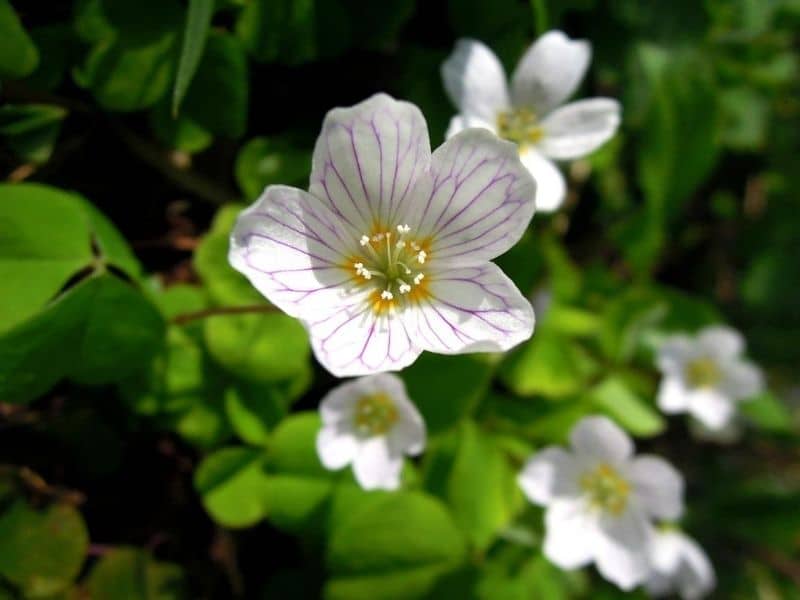
Soil
These plants thrive in well draining potting mix with a slightly acidic to neutral pH range. A mix of peat moss, perlite, and regular potting soil provides an excellent medium for False Shamrock growth.
Adequate soil moisture is essential, but overwatering should be avoided to prevent root rot. Regularly inspecting the soil moisture and repotting every 1-2 years can contribute to the overall health and vibrancy of False Shamrock plants.
Temperature and Humidity
False shamrocks do not tolerate temperatures beyond 24°C and below 16°C. They survive most indoor room temperatures but during the extreme weathers of winter and summer, false shamrocks may need to be moved around to avoid damage.
High temperatures and very humid conditions slow down the flowering of the purple shamrock plant (3). To help normalize the humidity around a potted oxalis, it can be placed on a wet pebble tray or misted in the morning and in the afternoon.
Pests and Disease
False shamrocks, like many soft-stemmed indoor plants, are vulnerable to sucking insects like aphids and mealybugs, snails, and spider mites. Swabbing the infestation with 70% isopropyl alcohol diluted in water is proven effective when done regularly until the pests have disappeared.
Sometimes infestations can grow out of hand rendering the plant wilted and dry. Oxalis is tough so removing all the leaves is okay and the bulb-like underground parts can be repotted with clean, healthy soil. This will grow into a whole new healthy plant in a month (3).
Propagation and Maintenance

False shamrocks are prolific growers that they tend to overcrowd in a pot easily. This is why they are effective groundcovers under the right conditions too. Propagate them by dividing the plant by the roots and repotting each resulting clump. A well-draining potting medium is ideally 2 parts soil, 1 part sand, and 1 part humus (2).
The newly potted plant can be placed in a sunny window. It will consume a lot of water during the growing season (4) and once new shoots appear, water only when the topsoil is dry.
After 3 to 4 weeks, the flowering plant begins to appear and continues to bloom profusely for several weeks. It is best to start fertilizing during this period, once a month moving forward.
You need not worry when the oxalis start to wither and the leaves to droop. Many false shamrock plants go into a dormancy period after the flowering period, which usually occurs in the summer. Watering should be put to a halt for a few months only resuming after the drying out period (2).
Top Oxalis Varieties for Indoor Use
Fanny
One of the more classic-looking oxalis, this variety became popular because of the green leaves with silver margins, providing an inviting contrast to the light purple flowers.
Iron Cross (O. tetraphylla)
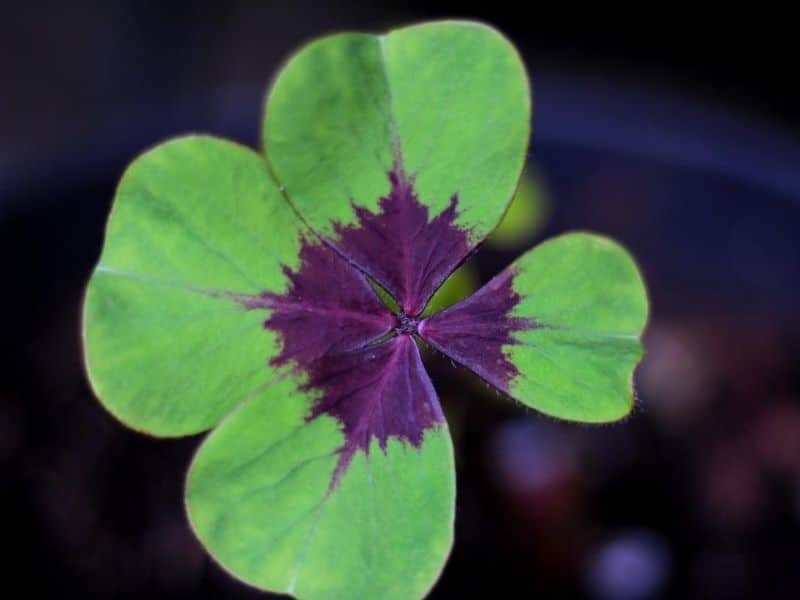
This false shamrock boasts 4 heart-shaped green leaves with a deep purple center that appears to be spreading to the rest of the leaves. The flowers are rosy pink with a yellow center.
Molten Lava (O. vulcanicola)
In a shaded area, the leaves of this oxalis are chartreuse but when placed under bright light, they transform into rich orange, complemented by the bright yellow delicate flowers.
Silver shamrock (O. adenophylla)
The pleated leaves of this oxalis are magnificent with its silvery gray color providing a soft background to the bigger, heavily-veined lilac and white flowers.
Triangularis (O. regnellii)
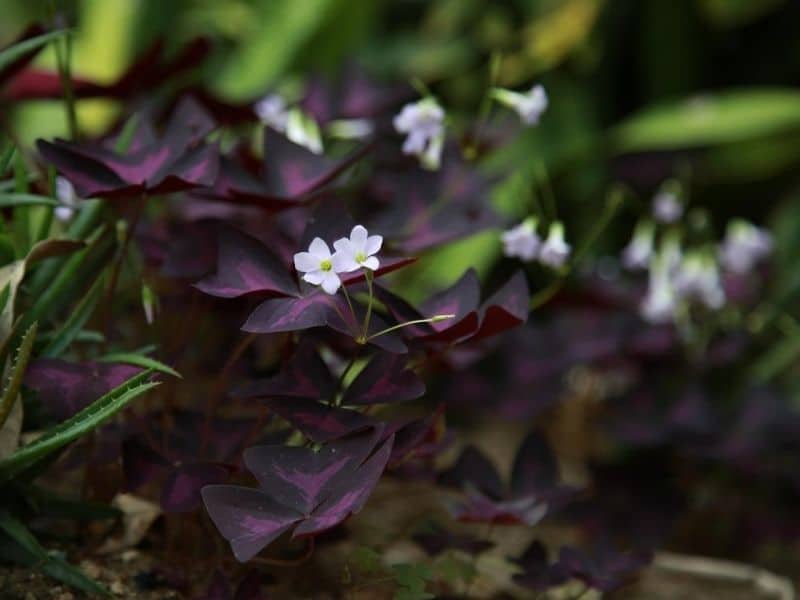
Oxalis triangularis is the most commonly grown oxalis indoors because of the striking foliage that is burgundy on both sides unlike most green species and varieties.
Zinfandel
Like the triangularis, this oxalis is deep purple from the leaves to the stem but what sets it apart is the minute clover-like foliage and bright yellow to golden flowers.
FAQs
Why is my false shamrock dying?
False shamrocks, also known as oxalis plants, may be dying due to various reasons such as overwatering, underwatering, poor soil drainage, or insufficient light. Assess the plant’s care conditions, adjust watering practices, and ensure it receives appropriate sunlight to promote its health.
Do false shamrocks close at night?
False shamrocks (oxalis) do not typically exhibit noticeable leaf movements like some other plants. Their leaves remain open during the day and night, and they don’t have a pronounced daily cycle of opening and closing.
How do you keep shamrocks alive?
To keep shamrocks (oxalis) alive, provide well-draining soil, water when the top inch of soil feels dry, and place the plant in bright, indirect light. Rotate the pot occasionally to ensure even growth, and fertilize with a balanced, water-soluble fertilizer during the growing season.
Why is my false shamrock turning green?
If your false shamrock (oxalis) is turning green, it could be due to insufficient light. These plants tend to exhibit more vibrant colors, often purple or burgundy, in higher light conditions. Move the plant to a location with brighter, indirect light to encourage the development of its characteristic coloration.
References
Reference list
(1) Sinnes, A. “Sunset House Plants”. 1963. Lane Publishing Company. P. 70.
(2) Carter, L. & Farr, J. “The Gardens of Emily Dickinson”. 2009. Harvard University Press. P. 367.
(3) Pleasant, B. “The Complete Houseplant Survival Manual”. 2012. Storey Publishing. P. 384.
(4) Sibley, E. “Urban Botanics: An Indoor Plant Guide to Modern Gardeners”. 2017. Aurum Press. P. 160.
Close
Image by PantherMediaSeller/depositphotos

